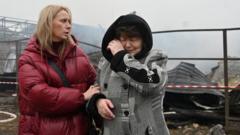As Ukraine faces the prospect of ongoing warfare, a combination of military fatigue and yearning for peace rises among its citizens and soldiers. After three years of intermittent conflict, many Ukrainian troops are exhausted and questioning the future. The continuing resistance against Russian advances, particularly around the besieged town of Kurakhove, is marking an intense chapter in their fight.
A distinguished mortar unit known as The Black Pack operates under considerable stress. The group, a diverse blend including a vegan chef, mechanic, web developer, and self-defined anarchists, aids in preventing encirclement as Russian forces close in from three fronts. Commanding officer Surt, a 31-year-old veteran, expressed hope initially that the war would end in three years but now braced himself mentally for a decade more. His realism informs his understanding of potential negotiations, while a cloud of uncertainty hangs over discussions of peace.
Former U.S. President Donald Trump's interest in brokering peace is noted, yet skepticism remains strong among many in Ukraine. Surt acknowledges Trump's ambition but worries about the compromises that may not secure justice for war victims. He and his comrades in arms display a resounding preference for continued resistance over negotiations, believing the horrors of their experience won’t warrant any semblance of restoration to what once existed.
This sentiment finds its embodiment in Serhiy, an ardent believer in the necessity of fighting. He argues that any negotiations would merely defer an inevitable resurgence of conflict. Davyd, an artist, reflects on the unpredictability of Trump's potential role in resolving the crisis, highlighting the enduring concerns regarding the actual outcomes of any proposals.
Intermittently, the unit engages in training to maintain their morale, even during rest periods. Their experiences are echoed by Denys, a new member who returned from Germany to join the fight. Despite feeling Ukraine is losing, he emphasizes the brutality of inaction over the challenges of battle.
Inside cities like Dnipro, residents struggle to reclaim pre-war normalcy. The barrage of missile attacks, combined with an urgent need for reprieve, compels many to seek resolution. Amidst this chaos, performances of culture serve both as distraction and commemoration. Audience members such as Ludmyla recognize a declining number of fellow countrymen, understanding that negotiation might be essential for Ukraine's future stability.
Visits to shelters reveal strong desires for peace, especially among the elderly who recall their homes with nostalgia and painful memories. Valentyna and Mariia represent a perspective echoing similar calls for negotiations, recognizing the futility of a purely military resolution. The prospect of land concessions raises complex ethical dilemmas, potentially demanding sacrifices from those most vulnerable.
As Ukraine stands at a crossroads, the dichotomy of desire to fight versus the longing for peace encapsulates a nation in profound turmoil. The dialogue surrounding negotiations remains divided, reflecting deeper socio-political fractures and a pervasive war-weariness. As the unfolding events continue to influence both military tactics and civilian life, the future of Ukraine remains uncertain amidst rising calls for resolution.


















